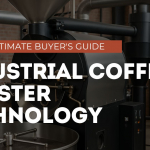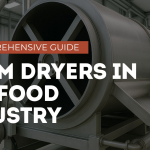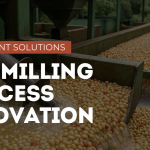Introduction
Tower dryers represent the backbone of efficient drying operations across numerous industries, from grain processing to food manufacturing. These vertical processing units are not merely equipment choices—they are critical investments that directly impact your operational efficiency, product quality, energy consumption, and ultimately, your bottom line.
When optimally sized and configured for your specific production volume, a tower dryer creates a perfect balance of throughput capacity and product quality. However, an improperly sized tower dryer can lead to significant consequences: undersized units create production bottlenecks and limit growth, while oversized systems waste energy, capital, and floor space while potentially compromising product quality through inconsistent drying.
The art of selecting the ideal tower dryer lies in achieving harmony between three crucial factors:
- Capacity: Ensuring the dryer can handle your current and projected throughput requirements
- Energy efficiency: Minimizing operational costs while maximizing production output
- Product quality: Maintaining consistent moisture content and product integrity throughout the drying process
This comprehensive guide will walk facility managers, agricultural producers, and food processing professionals through the systematic process of selecting the optimal tower drying system for their specific production volume and operational requirements.
Production Volume Assessment
Calculating Current Production Needs
Before exploring equipment specifications, you must first establish a clear understanding of your production requirements through systematic data collection and analysis:
- Baseline throughput measurement: Document your average daily, weekly, and monthly processing volumes over a complete production cycle
- Maximum throughput requirements: Identify peak production periods and record maximum daily processing volumes
- Product moisture analysis: Calculate the average initial moisture content of your product and the target final moisture percentage
- Operating schedule: Document current operating hours, shifts, and available production days
For existing operations, collect historical production data spanning at least 12 months to capture seasonal variations. For new processing lines, industry benchmarks and projected sales forecasts can provide reasonable baseline estimates.
Forecasting Future Capacity Requirements
While current production data provides a foundation, your tower dryer selection must accommodate your future growth trajectory:
- Strategic growth plans: Incorporate your company’s 3-5 year production targets
- Market analysis: Factor in industry growth trends and potential new market opportunities
- Product diversification: Consider potential new product lines requiring drying capacity
- Process optimization: Account for planned efficiency improvements that might increase throughput
Most drying system specialists recommend selecting equipment with 15-25% additional capacity beyond your current peak requirements to accommodate unexpected growth opportunities without creating immediate capital expenditure needs.
Seasonal Fluctuation Considerations
Many agricultural and food processing operations experience significant seasonal production variations that must be carefully factored into your tower dryer selection:
- Seasonal pattern identification: Map your production cycle to identify peak and valley periods
- Peak-to-average ratio calculation: Determine the relationship between your maximum and average production volumes
- Seasonal duration analysis: Document the length of your peak production periods
- Alternative product potential: Explore opportunities to process complementary products during off-peak seasons
For operations with pronounced seasonal patterns, modular drying solutions or systems with variable capacity settings may provide the operational flexibility required to maintain efficiency throughout the production cycle.
Peak Volume Handling Capabilities
Your tower dryer’s capacity to manage peak production periods without creating bottlenecks is essential to operational efficiency:
- Maximum daily throughput requirements: Establish your absolute peak daily processing volume
- Surge capacity needs: Determine if temporary storage systems can buffer production peaks
- Continuous vs. batch processing: Evaluate whether your operation requires continuous flow or can accommodate batch processing during peak periods
- Operating hour flexibility: Consider whether extending operating hours during peak seasons is feasible
The ideal tower dryer should handle your peak production volume without requiring more than 20 operating hours daily, providing buffer capacity for maintenance and unexpected production challenges.
Tower Dryer Types by Capacity
Small-Volume Tower Dryers (500-2,500 bushels/hour)
Key Features and Specifications
- Height range: 40-60 feet
- Diameter: 8-12 feet
- Energy consumption: 1,800-3,000 BTU per point of moisture removed per bushel
- Moisture reduction capability: 5-10 percentage points in a single pass
- Control systems: Basic automation with manual oversight requirements
- Modular design options: Limited expandability in most models
Ideal Applications and Product Types
- Small to medium grain farming operations
- Specialty crop processors (seeds, pulses, specialty grains)
- Pilot production facilities
- Regional feed mills
- Small-scale food ingredient processors
Space and Utility Requirements
- Foundation footprint: 15×15 to 25×25 feet
- Electrical requirements: 60-100 kW connected load
- Fuel supply: Natural gas connection (4-6″ line) or propane storage (1,000+ gallon tank)
- Minimum ceiling height: 65-85 feet
- Access requirements: Minimum 12-foot clearance for maintenance access
Capital and Operational Costs
- Initial investment range: $150,000-$350,000
- Installation costs: $45,000-$75,000
- Annual maintenance: $5,000-$12,000
- Energy costs per bushel: $0.04-$0.08 (natural gas at standard rates)
- Expected service life: 20-25 years with proper maintenance
Advantages and Limitations
Advantages:
- Lower initial capital investment
- Reduced space requirements
- Simplified maintenance procedures
- More manageable energy consumption
- Faster installation timeframe (8-12 weeks typical)
Limitations:
- Limited throughput capacity
- Fewer automation options
- Higher per-bushel processing costs
- Limited moisture extraction in a single pass
- Reduced energy efficiency compared to larger systems
Medium-Volume Tower Dryers (2,500-5,000 bushels/hour)
Key Features and Specifications
- Height range: 60-90 feet
- Diameter: 12-16 feet
- Energy consumption: 1,600-2,400 BTU per point of moisture removed per bushel
- Moisture reduction capability: 7-12 percentage points in a single pass
- Control systems: Advanced automation with remote monitoring capabilities
- Modular design options: Moderate expandability with additional sections
Ideal Applications and Product Types
- Medium to large farming operations
- Commercial grain elevators
- Regional food processors
- Animal feed manufacturing facilities
- Ethanol production facilities
- Mid-sized food ingredient manufacturers
Space and Utility Requirements
- Foundation footprint: 25×25 to 35×35 feet
- Electrical requirements: 100-175 kW connected load
- Fuel supply: Natural gas connection (6-8″ line) or propane storage (2,000+ gallon tank)
- Minimum ceiling height: 85-110 feet
- Access requirements: Minimum 16-foot clearance for maintenance access
Capital and Operational Costs
- Initial investment range: $350,000-$700,000
- Installation costs: $75,000-$150,000
- Annual maintenance: $12,000-$25,000
- Energy costs per bushel: $0.035-$0.06 (natural gas at standard rates)
- Expected service life: 25-30 years with proper maintenance
Advantages and Limitations
Advantages:
- Balanced capacity for growing operations
- Improved energy efficiency (10-15% better than small systems)
- Enhanced moisture control precision
- Advanced automation reducing labor requirements
- Better quality control through more even drying
Limitations:
- Significant capital investment required
- Complex installation requirements
- Higher infrastructure demands
- More specialized maintenance expertise needed
- Longer lead time for parts replacement
Large-Volume Tower Dryers (5,000-10,000+ bushels/hour)
Key Features and Specifications
- Height range: 80-120 feet
- Diameter: 16-24 feet
- Energy consumption: 1,400-1,800 BTU per point of moisture removed per bushel
- Moisture reduction capability: 8-15 percentage points in a single pass
- Control systems: Fully integrated automation with predictive maintenance and performance optimization
- Modular design options: Highly adaptable with significant expansion capabilities
Ideal Applications and Product Types
- Large commercial farming operations
- Major grain trading and storage facilities
- Industrial food processing plants
- Large-scale feed manufacturing operations
- Major food ingredient suppliers
- Export-focused agricultural processors
Space and Utility Requirements
- Foundation footprint: 35×35 to 50×50 feet
- Electrical requirements: 175-300+ kW connected load
- Fuel supply: Natural gas connection (8-12″ line) or dedicated fuel oil system
- Minimum ceiling height: 100-140 feet
- Access requirements: Full perimeter access with 20-foot clearance for maintenance
Capital and Operational Costs
- Initial investment range: $700,000-$1,500,000+
- Installation costs: $150,000-$350,000
- Annual maintenance: $25,000-$60,000
- Energy costs per bushel: $0.025-$0.045 (natural gas at standard rates)
- Expected service life: 30-40 years with proper maintenance
Advantages and Limitations
Advantages:
- Maximum throughput capacity
- Superior energy efficiency (20-30% better than small systems)
- Precise moisture control with multiple temperature zones
- Comprehensive automation reducing operational errors
- Lowest per-bushel processing costs
- Heat recovery systems reducing overall energy consumption
Limitations:
- Substantial capital investment
- Extensive site preparation requirements
- Complex installation logistics
- Specialized technical expertise required
- Significant utility infrastructure demands
- Longer installation timeframe (16-24 weeks typical)
Critical Selection Factors Beyond Volume
Product Moisture Content Requirements
The specific moisture characteristics of your product significantly impact tower dryer selection:
- Initial moisture variability: Products with highly variable initial moisture content require systems with advanced sensing and adaptive control capabilities
- Target moisture precision: Products with strict final moisture specifications need tower dryers with multi-stage temperature zones and precise control systems
- Moisture reduction range: Products requiring significant moisture reduction (10+ percentage points) benefit from systems with heat recovery and multi-pass capabilities
- Product sensitivity: Heat-sensitive products may require lower-temperature, longer-duration drying cycles, impacting throughput calculations
For products with critical moisture specifications, such as food ingredients or specialty grains, invest in systems with advanced moisture sensing at multiple points throughout the drying column.
Energy Source Availability and Costs
Your available energy sources and their relative costs can significantly impact both equipment selection and long-term operational expenses:
- Natural gas availability: The preferred energy source for most tower dryers, offering the lowest operational costs and cleanest combustion
- Propane considerations: Viable for operations without natural gas access, but typically increases operational costs by 30-45%
- Electric options: Available for specialty applications or locations with exceptionally low electricity costs, but generally less economical for large-scale operations
- Biomass potential: Some modern tower dryers can incorporate biomass energy sources, particularly beneficial for operations generating suitable waste products
Conduct a 10-year energy cost projection comparing available options before finalizing your tower dryer selection, as fuel costs typically represent 60-75% of total operational expenses.
Automation Needs
Modern tower dryers offer varying levels of automation, from basic control systems to fully integrated smart drying platforms:
- Basic control systems: Suitable for operations with dedicated drying staff and stable product characteristics
- Advanced monitoring: Recommended for operations with variable product moisture or quality requirements
- Fully automated systems: Essential for operations prioritizing labor efficiency or processing multiple product types
- Data integration capabilities: Valuable for facilities implementing comprehensive production tracking and quality control systems
When evaluating automation options, consider both current operational requirements and your broader technology strategy, as retrofitting advanced control systems can be costly and complicated.
Maintenance Considerations
Your maintenance capabilities and strategy should align with your tower dryer selection:
- In-house technical expertise: Assess your team’s capability to perform routine and emergency maintenance
- Service provider proximity: Evaluate the availability of qualified service technicians in your region
- Parts availability: Consider the manufacturer’s parts distribution network and typical lead times
- Preventative maintenance requirements: Compare the scheduled maintenance demands of different systems
- Remote diagnostics capabilities: Particularly valuable for operations in remote locations or with limited technical staff
The most technologically advanced tower dryer provides little value if your operation cannot maintain it properly. Balance equipment sophistication with your practical maintenance capabilities.
Future Expansion Compatibility
Your tower dryer represents a long-term infrastructure investment that should accommodate your strategic growth plans:
- Modular expansion options: Some tower dryer designs allow additional sections to increase capacity
- Control system scalability: Evaluate whether the control platform can integrate with additional equipment
- Utility service headroom: Ensure installed utilities can support potential system expansion
- Physical expansion space: Consider whether your site layout accommodates future equipment additions
- Technology upgrade path: Assess the manufacturer’s commitment to backwards-compatible improvements
Select a tower dryer with at least 25% capacity beyond your current peak requirements if significant growth is anticipated within the next five years.
ROI Calculation Framework
Calculating your tower dryer’s return on investment requires considering multiple factors beyond simple equipment costs:
Sample ROI Calculation Components
- Capital expenditure:
- Equipment purchase
- Installation costs
- Site preparation
- Utility connections
- Initial training
- Operational savings:
- Reduced labor costs
- Energy efficiency improvements
- Quality improvement value
- Capacity increase revenue potential
- Maintenance reduction
- Depreciation benefits:
- Equipment depreciation schedule
- Tax implications
Sample ROI Scenarios
Scenario 1: Small Producer Upgrading Legacy Equipment
- Investment: $275,000 (equipment + installation)
- Annual savings: $42,000 (energy efficiency + labor reduction)
- Additional revenue from increased capacity: $35,000 annually
- Maintenance reduction: $8,000 annually
- Simple payback period: 3.2 years
- 10-year ROI: 310%
Scenario 2: Medium Producer Expanding Capacity
- Investment: $525,000 (equipment + installation)
- Annual savings: $78,000 (energy efficiency + labor reduction)
- Additional revenue from increased capacity: $115,000 annually
- Maintenance reduction: $15,000 annually
- Simple payback period: 2.5 years
- 10-year ROI: 396%
Scenario 3: Large Producer Implementing State-of-the-Art System
- Investment: $1,200,000 (equipment + installation)
- Annual savings: $165,000 (energy efficiency + labor reduction)
- Additional revenue from increased capacity: $280,000 annually
- Maintenance reduction: $35,000 annually
- Simple payback period: 2.5 years
- 10-year ROI: 400%
Most operations achieve full ROI on modern tower drying systems within 2.5-4 years, with energy efficiency improvements typically delivering 30-45% of the total financial benefits.
Decision Matrix for Tower Dryer Selection
The following matrix provides a structured approach to evaluating potential tower dryer options against your specific operational requirements:
| Selection Criteria | Weight Factor | Option A Score | Option B Score | Option C Score |
|---|---|---|---|---|
| Production capacity match | 10 | × | × | × |
| Energy efficiency | 8 | × | × | × |
| Control system capability | 7 | × | × | × |
| Initial investment | 6 | × | × | × |
| Operating costs | 8 | × | × | × |
| Maintenance requirements | 7 | × | × | × |
| Expansion potential | 5 | × | × | × |
| Vendor support | 6 | × | × | × |
| Installation timeline | 4 | × | × | × |
| Expected service life | 5 | × | × | × |
| Total Score | Calculate | Calculate | Calculate |
For each potential tower dryer option, assign a score from 1-10 for each criterion, multiply by the weight factor, and sum the results. This structured approach helps quantify the comparative advantages of different systems based on your specific priorities.
Common Pitfalls in Tower Dryer Selection
Avoid these frequent mistakes that compromise tower dryer performance and return on investment:
Underestimating Capacity Requirements
The Pitfall: Selecting equipment based solely on average rather than peak production volumes The Impact: Production bottlenecks during high-demand periods The Solution: Size your tower dryer based on maximum anticipated throughput plus a 15-25% buffer
Overemphasizing Initial Cost
The Pitfall: Selecting the lowest-cost equipment without considering lifetime operational expenses The Impact: Higher long-term costs despite lower initial investment The Solution: Calculate 10-year total cost of ownership, including energy, maintenance, and labor
Neglecting Site Requirements
The Pitfall: Failing to thoroughly assess site foundation, utilities, and space constraints The Impact: Installation delays, additional site preparation costs, and operational compromises The Solution: Conduct a comprehensive site evaluation with engineering support before equipment selection
Overlooking Operator Capabilities
The Pitfall: Selecting overly complex systems without considering your team’s technical capabilities The Impact: Underutilized features, operational errors, and excessive service costs The Solution: Match automation complexity to your staff’s technical proficiency or invest in comprehensive training
Ignoring Product-Specific Requirements
The Pitfall: Selecting generic drying systems not optimized for your specific product characteristics The Impact: Quality inconsistencies, excessive energy consumption, and reduced throughput The Solution: Conduct product-specific drying tests with potential equipment suppliers
Undervaluing Vendor Support
The Pitfall: Failing to evaluate the manufacturer’s installation, training, and ongoing support capabilities The Impact: Extended commissioning periods, operational inefficiencies, and costly learning curves The Solution: Include vendor support quality and availability as key selection criteria
Case Study Examples
Case Study 1: Mid-Sized Grain Processor
Challenge: A regional grain processor faced capacity constraints during harvest season while struggling with energy costs from an aging drying system.
Analysis:
- Peak production requirement: 3,200 bushels/hour
- Energy consumption baseline: 2,800 BTU per point of moisture removed
- Quality inconsistency: ±1.8% moisture variation in final product
- Operational bottleneck: Drying capacity limiting receiving capacity
Solution Implemented:
- Installed 4,000 bushel/hour tower dryer with heat recovery system
- Advanced moisture control automation with multi-point sensing
- Integrated control system with existing grain handling equipment
Results:
- 25% increase in peak handling capacity
- 32% reduction in energy consumption per bushel
- Moisture consistency improved to ±0.4%
- ROI achieved in 2.7 years through energy savings and increased throughput
Case Study 2: Large-Scale Feed Manufacturer
Challenge: A major animal feed producer needed to expand capacity while improving product consistency across multiple feed formulations.
Analysis:
- Production requirement: 6,500 bushels/hour equivalent
- Multiple product types with varying moisture requirements
- Energy cost concerns due to facility location with high natural gas prices
- Limited expansion space within existing facility footprint
Solution Implemented:
- Installed 8,000 bushel/hour tower dryer with modular design
- Implemented programmable recipe control system for different feed formulations
- Incorporated advanced heat recovery and variable speed drives
- Designed vertical expansion to minimize footprint requirements
Results:
- Achieved 30% production increase within same facility footprint
- Reduced energy consumption by 28% despite increased throughput
- Improved batch-to-batch consistency with recipe-driven controls
- Enabled production of four new premium feed products with strict moisture specifications
Case Study 3: Specialty Food Ingredient Processor
Challenge: A specialty grain processor needed precise moisture control for organic ancient grains with minimal thermal impact on nutritional properties.
Analysis:
- Production requirement: 1,800 bushels/hour
- Critical final moisture specification: 11.2% ±0.3%
- Product sensitivity requiring gentle handling and precise temperature control
- Premium market requiring organic process certification
Solution Implemented:
- Installed 2,200 bushel/hour tower dryer with stainless steel food-grade components
- Multi-stage temperature zones with precision controls
- Integrated NIR moisture analysis with feedback control loop
- Specialized gentle handling components to minimize product damage
Results:
- Achieved moisture consistency of ±0.2%, exceeding specifications
- Preserved key nutritional markers with minimal thermal degradation
- Maintained organic certification through appropriate materials selection
- Reduced product rejection rate from 4.2% to 0.3%
Conclusion: Step-by-Step Selection Process
Selecting the optimal tower dryer for your production volume requires a systematic approach that balances current requirements with future flexibility:
- Document your production requirements:
- Establish baseline and peak throughput data
- Define product-specific drying parameters
- Map seasonal production variations
- Evaluate your operational context:
- Available energy sources and costs
- Site constraints and expansion potential
- Operator technical capabilities
- Maintenance support availability
- Develop your technical specifications:
- Required throughput capacity (current peak + 20%)
- Energy efficiency targets
- Control system capabilities
- Product-specific handling requirements
- Request detailed proposals from qualified manufacturers:
- Comprehensive equipment specifications
- Installation requirements and timeline
- Energy consumption guarantees
- Support and training programs
- References from similar operations
- Conduct comparative analysis:
- Apply the decision matrix to quantify advantages
- Calculate complete ROI projections
- Evaluate lifecycle costs
- Consider future expansion compatibility
- Finalize implementation planning:
- Detailed site preparation requirements
- Installation timeline and production impact
- Operator training schedule
- Performance validation criteria
By following this structured approach, you’ll select a tower drying system that delivers optimal performance for your specific production volume while providing the flexibility to accommodate future growth and evolving product requirements.
For successful implementation, remember that the ideal tower dryer balances three critical elements: sufficient capacity for your peak production volumes, energy efficiency to minimize operational costs, and precise control capabilities to ensure consistent product quality. When these elements align with your specific operational requirements, your tower drying system becomes a competitive advantage rather than merely a production necessity.




